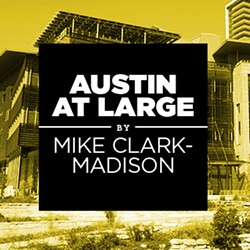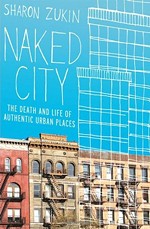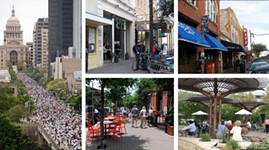Austin @ Large: A Healthy Heart
On making Central Austin more like West Campus -- and vice versa
By Mike Clark-Madison, Fri., Jan. 23, 2004

But many Central Austin denizens -- mighty proud of themselves for living the urban lifestyle -- would rather swallow ground glass than live in West Campus, and have fought repeated attempts to make their neighborhoods more like West Campus. Some of them have, in the draft Central Austin Combined Neighborhood Plan, come up with a new approach: Make West Campus more like West Campus. As we reported last week, the plan conceives a grand bargain: In return for slamming the brakes on creeping student infill projects in the single-family neighborhoods near UT, the neighbors have given unprecedented support to increasing the density of West Campus proper.
Under the terms of the plan's proposed University Neighborhood Overlay, existing residential high-rises like Dobie Center, the Castilian, and University Towers might end up being only slightly taller than the average building in West Campus. (The oft-cited comparison is to Chicago, but these heights and densities would be greater than much of Chicago.) The new buildings would be more carefully designed than those unloved present-day landmarks, with staggered setbacks to avoid the concrete-canyon effect and sidewalks and streetscapes actually designed to hold the number of people that should be living near UT.
The approach neatly reverses the last 20 years of city planning wisdom, which (reeling in shock from the bulk and brutality of Dobie and the Castilian) instead slammed the brakes on high-density West Campus infill.
Manufactured Blight
The result has been grim for Austin. An artificial housing shortage has made West Campus unaffordable to students (or anyone else) of average means, even as the condition of the properties themselves has grown more rank and embarrassing. Commercial spaces and corridors that should be home to the Weirdest of Austin's local businesses have instead been progressively chained out. For the most part, UT is now a commuter campus. Student warehouses, ill-served by the commerce or civic space their residents need, have been dumped far away where land is cheapest, which forces the Austinites with the least need and desire to own cars instead to add to our traffic jams. And on and on; the city has suffered the drawbacks of UT's massive size without realizing the benefits that could be captured by a truly urban setting for the campus.
At least on my list, none of these ill effects deal with the "character" of other UT-area neighborhoods. Too often, in the battles over projects like the Villas on Guadalupe and the various superduplexes -- which were admittedly horrible projects -- the neighbors have, perhaps unintentionally, made themselves part of the problem. Wealthy people in expensive houses a stone's throw from campus have worked overtime to keep students out of their neighborhoods, thus guaranteeing that the students who do make it through their gates will be the indolent frat boys, for whom money is no object, they most especially despise.
I've never quite understood why this is, but I know it's true; indeed, you can read it between the lines of the draft plan itself, with its call for UT to educate its students on how to be good neighbors. Why would you want to live near a big college campus if you weren't seeking the cultural vitality and diversity that comes, more than anything, from the students themselves? In most real big cities, proximity to a college campus serves to make neighborhoods more attractive, not less; universities keep boutique enclaves upscale and keep hard-bitten ghettos from total collapse. Yet West Campus is becoming sterile and blighted, and other campus neighborhoods strenuously turn their back on the university. This may show how far Austin has to go to become truly urban.
Aspiring to Collegiality
I don't much expect the neighbors' behavior pattern to change, but if adopting the UNO is simply a strategy to keep the vocal neighbors quiet, then the City Council should feel free to say no. But they should say yes to the benefits of the UNO to the whole city -- restoring affordability, recreating opportunities for local business, rewarding property owners for something other than exploitation and greed, and rubbing out the grimy visions of "student ghettos." As the authors of the draft plan and UNO acknowledge, a revitalized West Campus could and should be a 365-day-a-year neighborhood where nonstudents could feel at home and choose to live. Meanwhile, the real student ghettos -- along Far West Boulevard or Riverside Drive -- could themselves be reinvented, yielding up their ample supply of affordable housing to a diverse population that can help those neighborhoods likewise become functional urban districts.
Indeed, my biggest fear about the UNO is that it's too voluntary and laissez-faire. Many of the big-city infill strategies Austin has flirted with, but then eschewed, in other parts of town -- a nonprofit redevelopment authority, a tax-increment financing district -- make a lot of sense when applied to the limited area, obvious markets, and defined planning and design goals of West Campus and the UNO. Horse-trading strategies are in order -- for example, granting enhanced West Campus development rights and incentives to the owners of the reviled student slums in other neighborhoods, in return for taking the bulldozer to the latter. If encouraging central-city densities and bringing students closer to campus are as important citywide goals as City Hall (and Envision Central Texas!) say they are, then we should be prepared -- for once -- to go beyond the talking stage and make them realities.
Although it might sound uncool to say so, Austin has not grown so hip and cutting-edge that we can afford to ignore UT and treat its students like lepers. Sure, the town is far less UT-dependent than it used to be. But the campus community has likewise become more detached from Austin, and the city has lost access (or, at times, spurned access) to the economic and cultural rewards of being a college town. If nothing else, the UNO represents acknowledgement of a fact we'd almost forgotten: West Campus belongs to the city, not to the university. It is, in fact, very near the heart of our city, and it deserves special effort on the part of City Hall to keep it healthy. ![]()
Got something to say? The Chronicle welcomes opinion pieces on any topic from the community. Submit yours now at austinchronicle.com/opinion.








